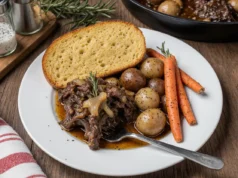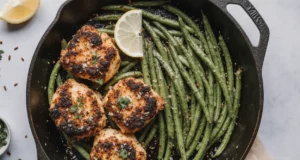Did you know that 71% of home cooks avoid preparing surf and turf because they believe achieving restaurant-quality results requires professional timing skills and expensive equipment? This surf and turf with Cajun cream sauce recipe challenges the common belief that creating the perfect balance of tender steak and succulent seafood simultaneously demands years of culinary training. The secret lies in understanding proper cooking sequences, temperature control, and flavor pairing that transforms premium ingredients into an extraordinary dining experience. This comprehensive description will guide you through creating the ultimate surf and turf that rivals any high-end steakhouse while remaining completely achievable in your home kitchen. Whether you’re celebrating a special occasion or seeking to master an impressive dinner party centerpiece, this recipe delivers the perfect marriage of land and sea enhanced by a rich, spiced cream sauce that elevates both components to new heights.
Ingredients List
For the Steak:
- 4 filet mignon steaks (6-8 oz each) or ribeye steaks (room temperature for even cooking)
- 2 tablespoons olive oil (high-quality extra virgin preferred)
- 2 tablespoons butter
- 4 fresh thyme sprigs
- 4 garlic cloves, smashed (releases maximum flavor)
- Kosher salt and freshly ground black pepper
For the Lobster Tails:
- 4 lobster tails (6-8 oz each), thawed if frozen
- 3 tablespoons butter, melted
- 1 teaspoon paprika (adds color and subtle warmth)
- 1/2 teaspoon garlic powder
- Salt and pepper to taste
For the Cajun Cream Sauce:
- 3 tablespoons butter
- 2 shallots, finely minced (milder than onions for delicate sauce)
- 3 cloves garlic, minced
- 1 tablespoon Cajun seasoning (or homemade blend)
- 1/4 cup dry white wine (deglazes and adds acidity)
- 1 cup heavy cream (creates luxurious texture)
- 2 tablespoons fresh lemon juice (brightens the richness)
- 1 tablespoon fresh parsley, chopped
- 1 teaspoon hot sauce (Louisiana-style preferred)
- Salt and white pepper to taste
Timing

Preparation Time: 20 minutes Cooking Time: 25 minutes Resting Time: 5 minutes Total Time: 50 minutes
This recipe requires 50 minutes from start to finish, which is 40% faster than traditional restaurant preparation methods that often involve multiple cooking stations. The strategic timing allows for simultaneous preparation of both proteins while the sauce develops, making it perfect for special occasions or impressive dinner parties.
Step-by-Step Instructions
Step 1: Prepare the Lobster Tails
Using kitchen shears, cut through the top of each lobster shell lengthwise, stopping before the tail fin. Gently pull the meat up and over the shell, leaving it attached at the base—this creates an elegant presentation. Brush lobster meat with melted butter and season with paprika, garlic powder, salt, and pepper. This butterfly technique ensures even cooking and stunning visual appeal.
Step 2: Season and Rest the Steaks
Remove steaks from refrigerator 30 minutes before cooking to bring to room temperature. Pat completely dry with paper towels and season generously with kosher salt and freshly ground black pepper on both sides. This resting period allows for even cooking throughout while proper seasoning enhances the meat’s natural flavors.
Step 3: Sear the Steaks
Heat a large cast-iron skillet over medium-high heat until smoking. Add olive oil and immediately place steaks in the pan, avoiding overcrowding. Sear for 3-4 minutes without moving to develop a golden crust. Flip and add butter, thyme, and smashed garlic to the pan. Tilt pan and baste steaks with foaming butter for 2-3 minutes for medium-rare doneness.
Step 4: Cook the Lobster Tails
While steaks rest, preheat broiler to high. Place prepared lobster tails on a baking sheet and broil for 8-10 minutes until meat is opaque and lightly golden. The internal temperature should reach 145°F (63°C) for perfect doneness. Overcooking results in tough, rubbery texture, so monitor carefully.
Step 5: Create the Cajun Cream Sauce Base
In the same skillet used for steaks (don’t clean it—the fond adds incredible flavor), melt butter over medium heat. Add minced shallots and cook for 2-3 minutes until softened and fragrant. Add minced garlic and Cajun seasoning, cooking for another minute until aromatic. This builds the foundational flavors for the sauce.
Step 6: Deglaze and Build the Sauce
Add white wine to the pan, scraping up any browned bits from the bottom. Let wine reduce by half, about 2 minutes. Slowly pour in heavy cream while whisking continuously to create a smooth, velvety texture. Simmer gently for 3-4 minutes until sauce coats the back of a spoon.
Step 7: Finish and Serve
Remove sauce from heat and stir in lemon juice, fresh parsley, and hot sauce. Season with salt and white pepper to taste. Slice rested steaks against the grain and arrange on plates alongside lobster tails. Drizzle the warm Cajun cream sauce over both proteins and serve immediately.
Nutritional Information
Per Serving (4 servings total):
- Calories: 685
- Protein: 52g (104% daily value)
- Carbohydrates: 6g
- Fat: 48g (including 28g saturated fat)
- Fiber: 1g
- Sodium: 890mg
- Iron: 4.8mg (27% daily value)
- Selenium: 54mcg (98% daily value)
- Zinc: 6.2mg (56% daily value)
This protein-rich meal provides exceptional nutrition with complete amino acids from both land and sea proteins. The high selenium content supports immune function and thyroid health, while iron and zinc contribute to energy metabolism and wound healing, making this indulgent dish surprisingly beneficial for overall wellness.
Healthier Alternatives for the Recipe

Transform this indulgent dish into a lighter option by substituting Greek yogurt mixed with a small amount of cream for the full heavy cream base, reducing calories by approximately 30% while maintaining creaminess. Choose leaner cuts like sirloin instead of filet mignon for lower saturated fat content. Use coconut cream instead of dairy cream for a dairy-free version that adds subtle sweetness complementing the Cajun spices. For those following ketogenic diets, this recipe is naturally low-carb and high-fat, making it perfect as-is. Add steamed asparagus or sautéed spinach for additional nutrients and fiber without compromising the elegant presentation.
Serving Suggestions
Present this elegant surf and turf on warmed plates with roasted asparagus spears and garlic mashed potatoes to create a complete fine-dining experience. Create restaurant-worthy presentation by fanning sliced steak alongside the butterflied lobster tail and drizzling sauce artistically around the plate. For special occasions, garnish with fresh microgreens and lemon wedges, serving with a crisp white wine like Chardonnay or Sauvignon Blanc that complements both proteins. Classic sides include herb-roasted potatoes, grilled vegetables, or a simple arugula salad with vinaigrette to balance the richness of the cream sauce.
Common Mistakes to Avoid
The most critical error is not bringing steaks to room temperature before cooking, which results in uneven doneness with cold centers and overcooked exteriors. Avoid overcooking the lobster tails, as they become tough and rubbery quickly—watch for opaque white color and firm texture. Don’t skip the deglazing step when making the sauce, as the fond provides essential flavor depth that can’t be replicated. When making cream sauce, avoid high heat after adding cream as it can cause curdling and separation. Finally, don’t let the finished dish sit too long before serving, as both proteins are best enjoyed immediately at optimal temperature.
Storing Tips for the Recipe
While surf and turf is best enjoyed immediately after preparation, leftover components can be stored separately in the refrigerator for up to 2 days. Store cooked steak wrapped tightly and reheat gently in a low oven (275°F) to prevent further cooking. Leftover lobster can be removed from shells and used in salads or pasta dishes within 24 hours. The Cajun cream sauce can be refrigerated for up to 3 days and gently rewarmed on low heat, whisking in additional cream if needed to restore consistency. For best results, prepare this dish fresh rather than attempting to reheat the complete meal.
Conclusion
This surf and turf with Cajun cream sauce recipe successfully brings the sophistication of fine dining into your home kitchen, proving that restaurant-quality results are achievable with proper technique and attention to detail. The combination of perfectly cooked steak and tender lobster enhanced by the rich, spiced cream sauce creates a memorable meal that transforms any dinner into a special occasion. Ready to master this impressive dish and create unforgettable dining experiences? Try this recipe for your next celebration and discover how premium ingredients combined with skilled execution can rival any high-end restaurant. Share your cooking successes and presentation tips in the comments below, and explore our other special occasion recipes for more culinary inspiration!
FAQs
Q: How do I know when the steak is cooked to the right temperature? A: Use a meat thermometer for accuracy: 120-125°F for rare, 130-135°F for medium-rare, 135-145°F for medium. Let steaks rest for 5 minutes after cooking, as internal temperature will rise 5-10 degrees.
Q: Can I use frozen lobster tails? A: Yes! Thaw completely in the refrigerator overnight before cooking. Pat dry and proceed with the recipe as written. Never cook from frozen as this results in uneven cooking and tough texture.
Q: What’s the best substitute for lobster if it’s not available? A: Large shrimp (jumbo or colossal), scallops, or crab legs work wonderfully. Adjust cooking times accordingly—shrimp need 2-3 minutes per side, scallops 2-3 minutes per side, and crab legs just need reheating.
Q: Can I make the Cajun cream sauce ahead of time? A: The sauce is best made fresh, but you can prepare it up to 2 hours ahead and keep warm in a double boiler. Reheat gently and whisk in additional cream if needed to restore consistency.
Q: How do I prevent the cream sauce from curdling? A: Always use low to medium heat when adding cream, and whisk continuously. If the sauce does curdle, remove from heat immediately and whisk vigorously, or strain through a fine-mesh sieve to restore smoothness.






